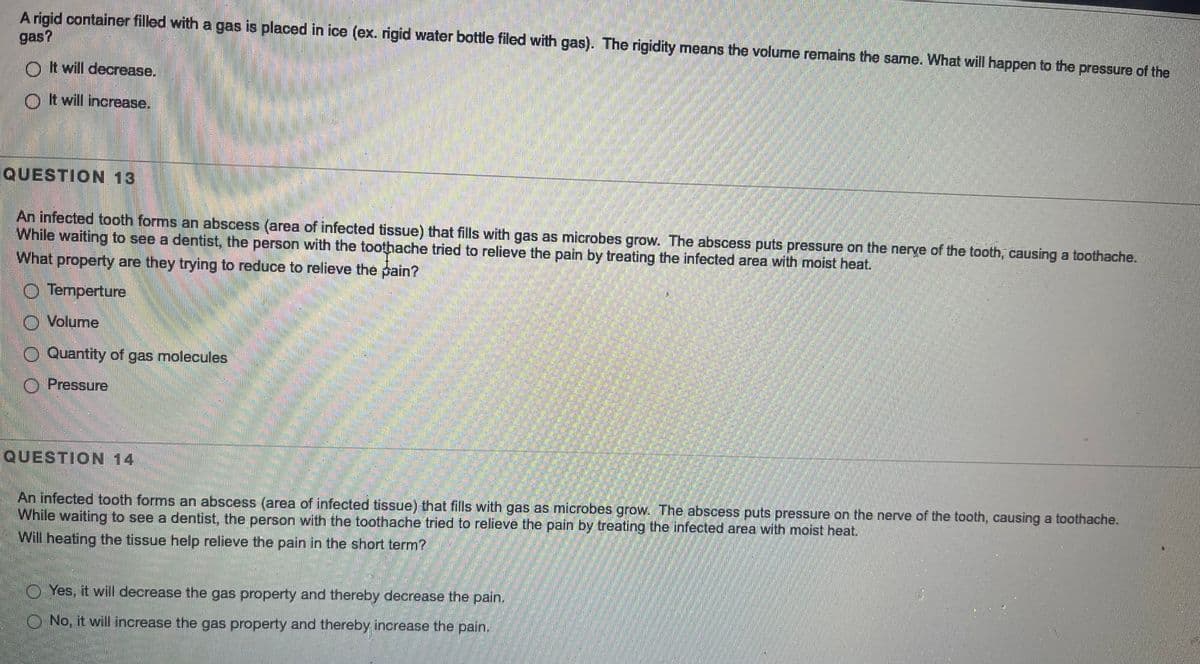A rigid container filled with a gas is placed in ice (ex. rigid water bottle filed with gas). The rigidity means the volume remains the same. What will happen to the pressure of the gas? O t will decrease. O It will increase. QUESTION 13
A rigid container filled with a gas is placed in ice (ex. rigid water bottle filed with gas). The rigidity means the volume remains the same. What will happen to the pressure of the gas? O t will decrease. O It will increase. QUESTION 13
Chemistry
10th Edition
ISBN:9781305957404
Author:Steven S. Zumdahl, Susan A. Zumdahl, Donald J. DeCoste
Publisher:Steven S. Zumdahl, Susan A. Zumdahl, Donald J. DeCoste
Chapter5: Gases
Section: Chapter Questions
Problem 130E
Related questions
Question

Transcribed Image Text:Description You will use an online simulation to manipulate and calculate the four properties of gases: Pressure, Volume, Quantity, and Temperature. You will also apply your knowledge to several scenarios.
To begin, open the simulation, Gases Intro, from https://phet.colorado.edu/sims/html/gases-intro/latest/gases-intro en.html. This will open it in another window. Select the simulation box Intro at the bottom. When
it opens, check Width to show the width of the box. You should leave the rest unchecked. We will only use Heavy Particles. Play around with the simulation to see how to adjust the volume/width (handle on left of
box), temperature (bucket below with either ice or fire), and quantity (using the pump handle to right of the box). Keep the box sealed by keeping top door closed. When you are ready to do the experiments,
reset the simulation by pressing the white eraser button on bottom right, make sure width is 10.0 nm, and set to heavy particles (purple gas molecules).
Instructions To do first experiment, pump the gas pump to put gas into the chamber. Only use between 3 and 7 pumps. Increase the temperature to a number you like between 100 K and 500 K, using the fire/ice bucket on
bottom. Do not change the chamber width for now, keep it at 10.0 nm (handle on left of chamber). Do not open the chamber to let gas molecules out (handle on top of chamber).
Calculating moles using the Ideal Gas Law: PV nRT, where R = 0.0821
Once you have everything how you like it, you will calculate how many moles of gas are in the chamber, by using the Ideal Gas Law. Recall the Ideal Gas Law requires specific units: atm, L, moles, and Kelvin.
Pressure
Is indicated by the circular instrument on the top right of the chamber. It is conveniently already in atmospheres.
Volume - Determine the volume in nm^3 by multiplying the width, height, and depth of the chamber. Depth is always 1.00 nm and height is always 10.0 nm. Width is adjusted by you to 10.0 nm or 15.0 nm,
depending on the experiment. Volume then is: width you adjust X 10.0 nm X 1.00 nm. Simplifying, it is the width you select X 10.0, with units of nm^3. To simplify calculations assume your volume answer in nm^3 are
actually Liters (L), when calculating the Ideal Gas Law.
Temperature- This is indicated by the thermometer, conveniently already in units Kelvin.
Quantity- for these experiments you will be calculating the quantity, or moles, of gas under each scenario. What is the solution when you solve the Ideal Gas Law, PV=nRT, for n, moles? R = 0.0821.

Transcribed Image Text:A rigid container filled with a gas is placed in ice (ex. rigid water bottle filed with gas). The rigidity means the volume remains the same. What will happen to the pressure of the
gas?
O t will decrease.
O t will increase.
QUESTION13
An infected tooth forms an abscess (area of infected tissue) that fills with gas as microbes grow. The abscess puts pressure on the nerve of the tooth, causing a toothache.
While waiting to see a dentist, the person with the toothache tried to relieve the pain by treating the infected area with moist heat.
What property are they trying to reduce to relieve the pain?
Temperture
O Volume
OQuantity of gas molecules
Pressure
QUESTION 14
An infected tooth forms an abscess (area of infected tissue) that fills with gas as microbes grow. The abscess puts pressure on the nerve of the tooth, causing a toothache.
While waiting to see a dentist, the person with the toothache tried to relieve the pain by treating the infected area with moist heat.
Will heating the tissue help relieve the pain in the short term?
O Yes, it will decrease the gas property and thereby decrease the pain.
No, it will increase the gas property and thereby increase the pain.
Expert Solution
This question has been solved!
Explore an expertly crafted, step-by-step solution for a thorough understanding of key concepts.
This is a popular solution!
Trending now
This is a popular solution!
Step by step
Solved in 2 steps

Knowledge Booster
Learn more about
Need a deep-dive on the concept behind this application? Look no further. Learn more about this topic, chemistry and related others by exploring similar questions and additional content below.Recommended textbooks for you

Chemistry
Chemistry
ISBN:
9781305957404
Author:
Steven S. Zumdahl, Susan A. Zumdahl, Donald J. DeCoste
Publisher:
Cengage Learning


Chemistry: An Atoms First Approach
Chemistry
ISBN:
9781305079243
Author:
Steven S. Zumdahl, Susan A. Zumdahl
Publisher:
Cengage Learning

Chemistry
Chemistry
ISBN:
9781305957404
Author:
Steven S. Zumdahl, Susan A. Zumdahl, Donald J. DeCoste
Publisher:
Cengage Learning


Chemistry: An Atoms First Approach
Chemistry
ISBN:
9781305079243
Author:
Steven S. Zumdahl, Susan A. Zumdahl
Publisher:
Cengage Learning

Physical Chemistry
Chemistry
ISBN:
9781133958437
Author:
Ball, David W. (david Warren), BAER, Tomas
Publisher:
Wadsworth Cengage Learning,

Introductory Chemistry: A Foundation
Chemistry
ISBN:
9781337399425
Author:
Steven S. Zumdahl, Donald J. DeCoste
Publisher:
Cengage Learning